AI in the Workplace Statistics 2024
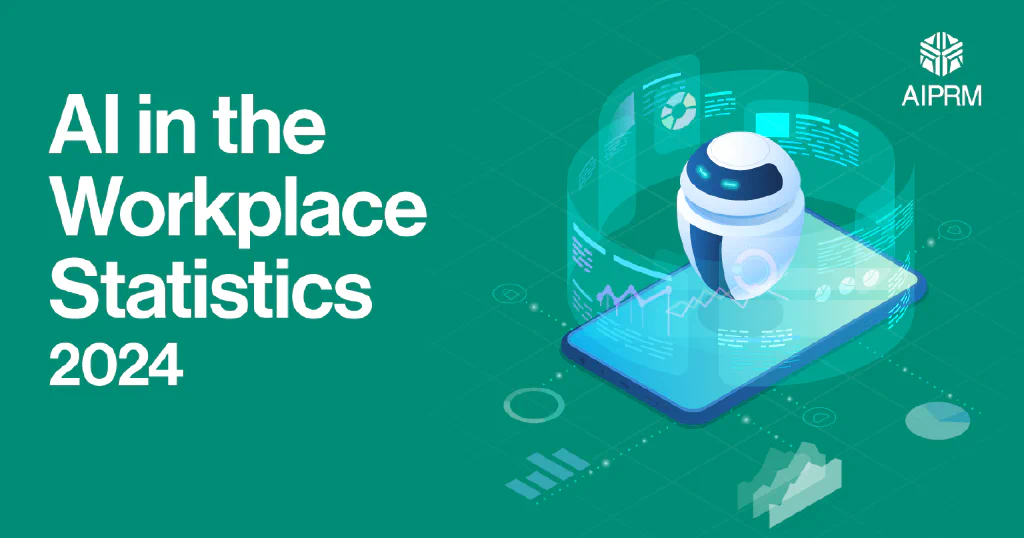
Conversations around AI’s effect on the workplace have been prevalent for decades. From excitement about how the technology could enhance productivity, to fears around job displacement, AI’s presence in the workplace inspires much debate.
Since the beginning of the AI boom in 2022, these conversations have accelerated, with topics that once felt like part of a distant future now highly relevant to the lives of workers and businesses worldwide.
But what does the future hold for the use of AI in the workplace? To shed more light on this much-discussed topic, AIPRM has collated a whole host of AI in the workplace statistics, covering AI adoption by industry, the jobs most at risk from AI, and more.
Top 10 AI in the workplace statistics #
- Three-quarters (75%) of surveyed workers were using AI in the workplace in 2024.
- Of these, nearly half (46%) began doing so within the last six months.
- 75% of companies said they were looking to adapt to AI within the next five years in 2023.
- Over a third (37%) of marketing and advertising sector workers had adopted AI at work in 2023.
- More than two-thirds (68%) of business leaders feel they have struggled to attract adequate talent to manage their AI solutions.
- In 2024, 45% of workers claimed they were worried about AI replacing them at work.
- Nine out of ten (90%) surveyed workers claimed that AI helped them save time on tasks in 2024.
- 29% of business leaders said they approved of AI in the workplace, with a further 12% saying they strongly approved.
- Programmers using AI were able to code 126% more projects per week than programmers not using the technology.
- Nearly two-thirds (65%) of surveyed workers claimed they’d used ChatGPT in the workplace.
How many people use AI at work? #
Recent AI in the workplace statistics from Microsoft found that three-quarters (75%) of surveyed workers were using AI in the workplace in 2024, with only one in four (25%) yet to use the technology.
A breakdown of the percentage of surveyed respondents using AI in the workplace (2024) #
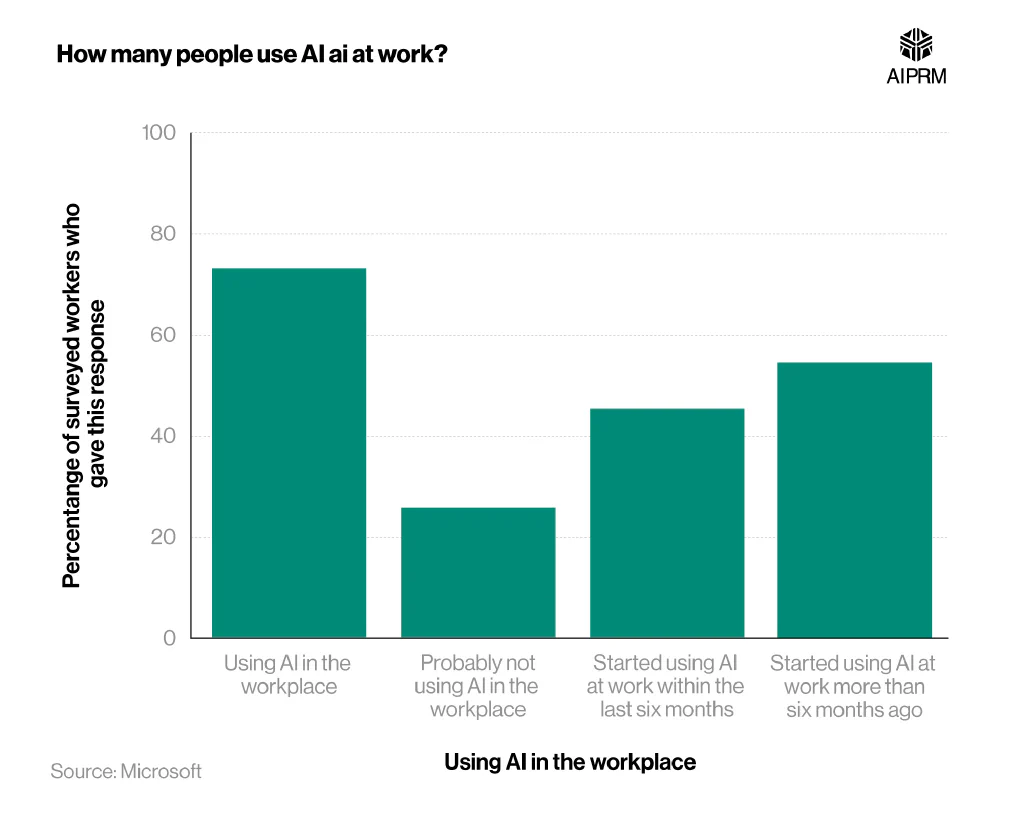
Of the workers using AI at work, nearly half (46%) began doing so within the last six months, with the remaining 54% having used it for longer.
The same survey found that nearly four-fifths (79%) of company leaders feel their company needs to adopt AI to stay competitive, with around three-fifths (59%) worried about their ability to measure the productivity gains of AI.
Additionally, a further 60% of business leaders said they were worried that their organization’s leadership lacked a plan or vision to implement AI in the workplace.
How are companies planning to adapt to AI? #
A 2023 survey from the World Economic Forum reported that around 75% of companies were looking to adapt to AI within the next five years. Digital platforms and apps were the technologies most referenced by business leaders, with 86% expecting to incorporate them into company operations between 2023 and 2027.
A breakdown of the percentage of surveyed organizations who say they’re likely or highly likely to adopt various technology types between 2023 and 2027 #
| Technology | Percentage of surveyed organizations who are likely or highly likely to adopt this technology between 2023 and 2027 |
|---|---|
| Digital platforms and apps | 86.4% |
| Education and workforce development technologies | 80.9% |
| Big-data analytics | 80% |
| Internet of things and connected devices | 76.8% |
| Cloud computing | 76.6% |
| Encryption and cybersecurity | 75.6% |
| E-commerce and digital trade | 75.3% |
| Artificial intelligence | 74.9% |
| Environmental management technologies | 64.5% |
| Climate-change mitigation technology | 62.8% |
| Text, image, and voice processing | 61.8% |
| Augmented and virtual reality | 59.1% |
| Power storage and generation | 52.1% |
| Electric and autonomous vehicles | 51.5% |
| Robots, non-humanoid | 51.3% |
(Source: World Economic Forum)
AI in the workplace stats show that more than four-fifths (81%) of businesses plan to implement technology for education and workforce development over the next five years — the second most common reason.
Big data analytics was the only other purpose cited by at least four-fifths of businesses, with 80% planning to develop their resources in this area. E-commerce and digital trade are expected to be adopted by around three-quarters (75%) of businesses — 11% less than the number planning to adopt digital platforms and apps.
At the other end of the scale, just over half (51%) of companies planned to utilize robots and non-humanoid technology, with a slightly higher percentage (52%) citing the use of electric and autonomous vehicles.
What industries are adopting AI in the workplace? #
The latest AI in the workplace statistics found that over a third (37%) of workers in the marketing and advertising sector had adopted AI at work. This was the highest percentage of any industry — 2% more than second-placed technology.
An industry-based breakdown of the percentage of workers that have adopted AI in the workplace (2023) #

Three-tenths (30%) of consultants had adopted AI at work, making it the third most common industry and the only other one with an adoption rate of at least 30%.
Just under two-fifths (19%) of teachers had adopted AI at work, which was 3% more than the percentage of accountants who had done the same (16%). Healthcare had the lowest total of all sectors, with an adoption rate of 15% — less than half the number reported by the advertising and consulting industries.
Visit our AI in healthcare statistics page for key insights into how AI is transforming aspects of the healthcare industry.
How much are people using AI at work? #
A report from tech.co found that just over a third (34%) of business leaders said AI was not being used at all in the workplace. This was the most common response given, with a slightly lower number (33%) saying the technology is being used to a limited extent.
A breakdown of the extent to which AI is being used in the workplace among surveyed business leaders #

Over a fifth of business leaders claimed AI is being used moderately in the workplace, around triple the number who were using it extensively (7%).
Less than one in twenty (5%) claimed that their organization had fully embraced AI at work, which was over seven times less than the number who weren’t using it at all.
AI tools and technologies #
According to AI statistics, more than two-thirds (68%) of business leaders feel they have struggled to attract adequate talent to manage their AI solutions. This is despite the fact that companies investing in artificial intelligence have seen their customer satisfaction rates more than double, on average.
What are the most common AI tools used at work? #
ChatGPT is the most commonly used AI tool among workers, with nearly two-thirds (65%) claiming they’d used the OpenAI chatbot in the workplace. This was 12% higher than any other tool, making it the only one cited by more than half of workers, according to ChatGPT statistics.
A breakdown of the percentage of surveyed workers who reported using various AI tools in the workplace #

Just under half (48%) had used Google Gemini (formerly Bard), making it the second-most common tool. This was more than double the total of Microsoft Copilot (formerly Bing Chat) (21%) which was the only other platform referenced by over a fifth of workers.
At the other end of the scale, around than a tenth reported using either Claude AI (10%) or Jasper (9%) at work, with just 8% referencing any other tools.
What are the most common reasons people are using AI in the workplace? #
Recent AI in the workplace statistics found that nearly a third (32%) of surveyed workers were using AI to analyze data at work. This was 6% more than any other reason, making data analysis the only one cited by over 30% of workers.
A breakdown of the most common functions people use AI for in the workplace #
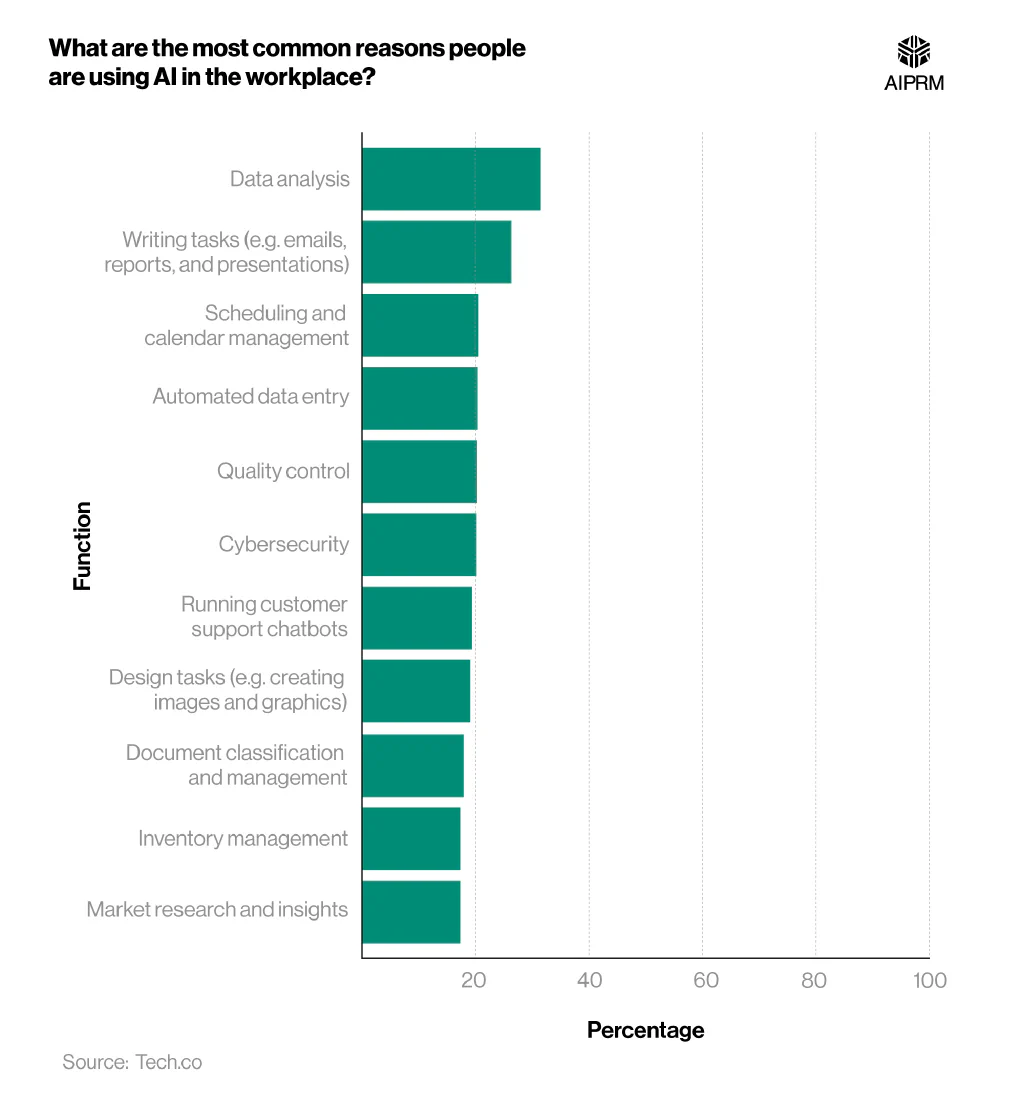
Over a quarter (26%) use AI to help with writing tasks like emails, reports, and presentations. This was 5% more than the next highest response, with over a fifth (21%) citing scheduling and calendar management.
The only other functions cited by at least a fifth of respondents were automated data entry, quality control, and cybersecurity, with each being mentioned by 20%.
Attitudes towards AI in the workplace #
Nine out of ten (90%) surveyed workers claimed that AI helped them save time on work tasks. This was 5% more than any other benefit, with 85% claiming that AI helps them focus on their most important work.
A breakdown of the most common improvements cited by workers as a result of AI #

Analysis of AI in the workplace statistics shows that over four-fifths (84%) felt that AI allows them to be more creative at work, with a similar number (83%) feeling that the technology has made work more enjoyable.
What are the most common fears about AI in the workplace? #
According to a 2024 Microsoft survey, more than half of workers (53%) claimed they were worried that using AI for work tasks would make them look replaceable to their employers. This was the most commonly cited fear, with a further 52% expressing reluctance to admit using AI for important tasks.
A breakdown of the most common fears about AI cited by surveyed workers #
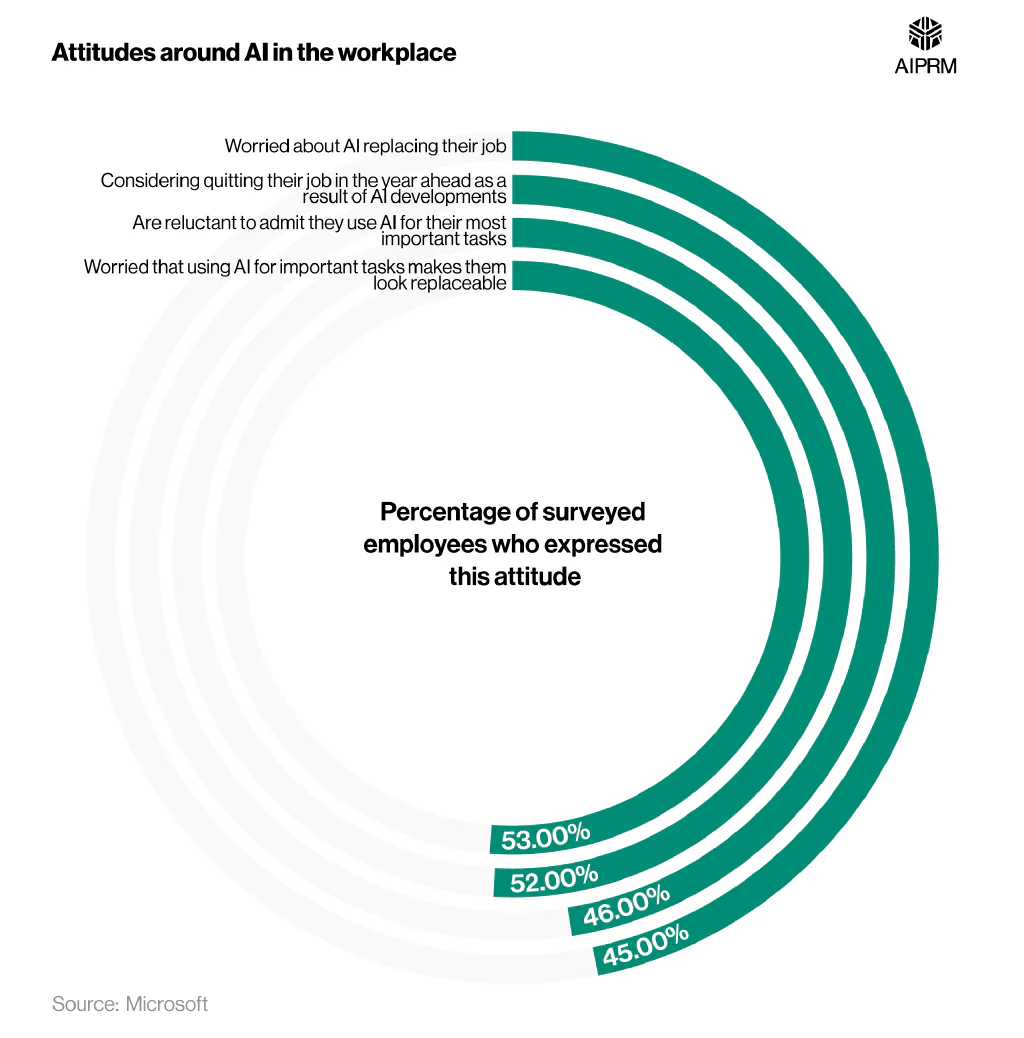
Statistics around AI replacing jobs found that just under half (46%) of workers are considering quitting their jobs in the year ahead, with a further 45% expressing worry about AI replacing them at work.
Elsewhere, a 2023 survey from the American Psychological Association found that nearly four out of ten U.S. workers (38%) were worried AI may make some or all of their job duties obsolete in the future.
Of these, 51% said their work had a negative impact on their mental health, with this number falling to 29% among workers not worried about AI making their jobs obsolete.
Are businesses happy about AI in the workplace? #
There is more positivity than negativity about AI among business leaders, with around 29% saying they approve of the technology in the workplace. Additionally, a further 12.23% said they strongly approved of AI, meaning over 40% of business leaders approve of AI to some extent.
A breakdown of the happiness levels of business leaders around AI in the workplace #
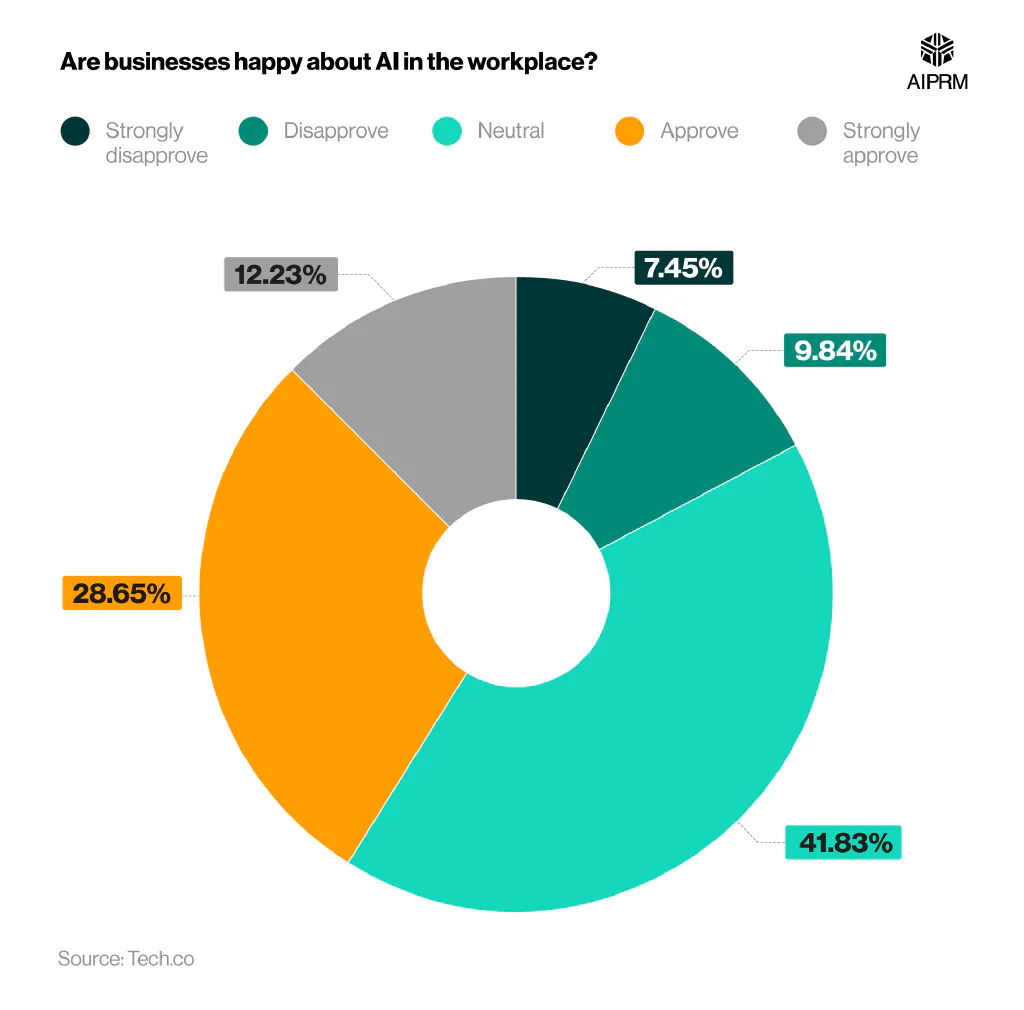
Conversely, just under 10% of business leaders said they disapproved of AI in the workplace, with a further 7.45% strongly disapproving. This means that the number of business leaders who approved of AI to some extent was more than double the total that disapproved.
Over two-fifths (41.83%) of respondents said they were neutral about AI in the workplace — the most common answer given.
The changing perceptions of AI among business leaders #
More than two-thirds (68%) of business leaders claimed they’d struggled to attract adequate talent to manage their AI tools effectively, according to a 2024 report from Spiceworks. The same article reported that four-fifths (80%) of engineering and manufacturing companies had reported hiring challenges in the wake of AI.
A breakdown of the attitudes around AI in the workplace among surveyed business leaders #

Despite these struggles, more than half of business leaders (52%) believe AI will significantly improve their operations in the future, with over a third (35%) planning to hire AI-related talent in the near future.
What are the benefits of AI in the workplace? #
A report from Workplace via Meta looked at how AI could be best integrated to generate measurable value. The report concluded that mere adoption alone would not significantly improve workplace performance. AI needs to be combined with new ways of working, staff reskilling, and a culture of innovation and experimentation.
The report demonstrated these views by referencing a study from the IBM Institute for Business Value. The study found that AI adopters that also outperform expectations on reskilling staff see a 36% revenue growth rate premium over standard AI adopters.
The report also defined six performance categories to determine ‘best-in-class’ AI-performing companies, they were:
- Vision and strategy
- An AI operating model
- AI engineering and operations
- Data and technology
- Sufficient talent and skills
- Culture and adoption.
Best-in-class companies that had developed all six of these capabilities reported an average ROI of 13% on AI projects.
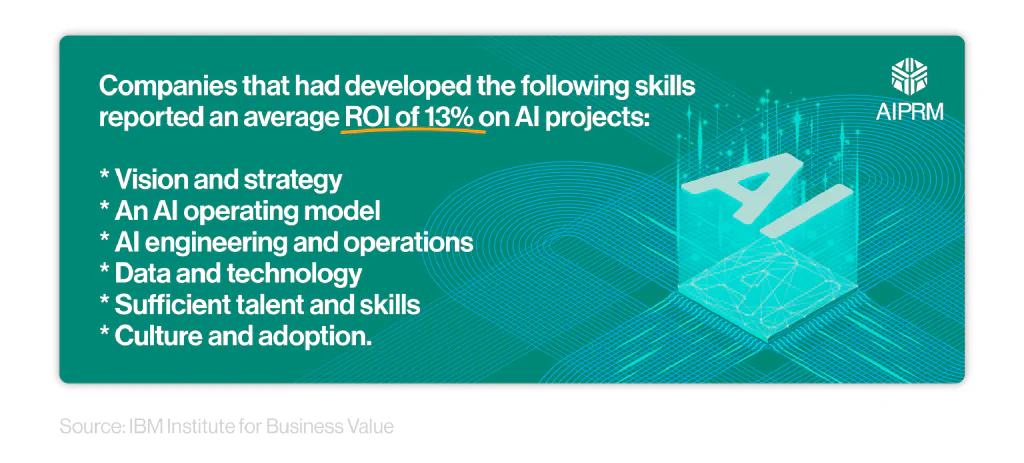
AI effect on jobs #
Recent AI in the workplace statistics predicted that 83 million jobs could be lost globally between 2023 and 2027. This is around a fifth (20%) more than the number of jobs expected to be created in this period (69 million), suggesting that AI’s development could have a significant impact on the global workforce.
A breakdown of the projected changes in global employment between 2023 and 2027 #
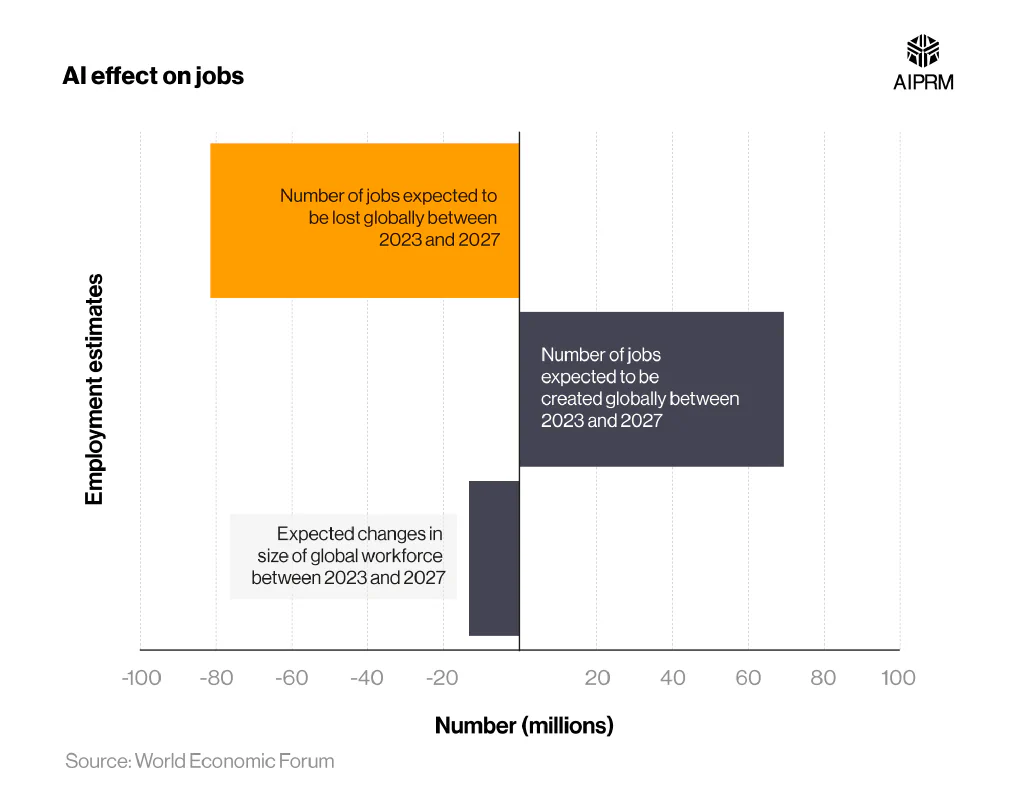
If these projections are correct, then the global workforce will shrink by 14 million people between 2023 and 2027.
Which jobs are expected to see the biggest workforce increases between 2023 and 2027? #
Agricultural equipment operators are expected to see their workforce increase by approximately 2.6 million between 2023 and 2027 — the highest of any occupation. This was roughly 18% more than any other job, making agricultural equipment operations the only one with projected increases above 2.5 million.
A breakdown of the jobs with the highest anticipated employment increases between 2023 and 2027 #
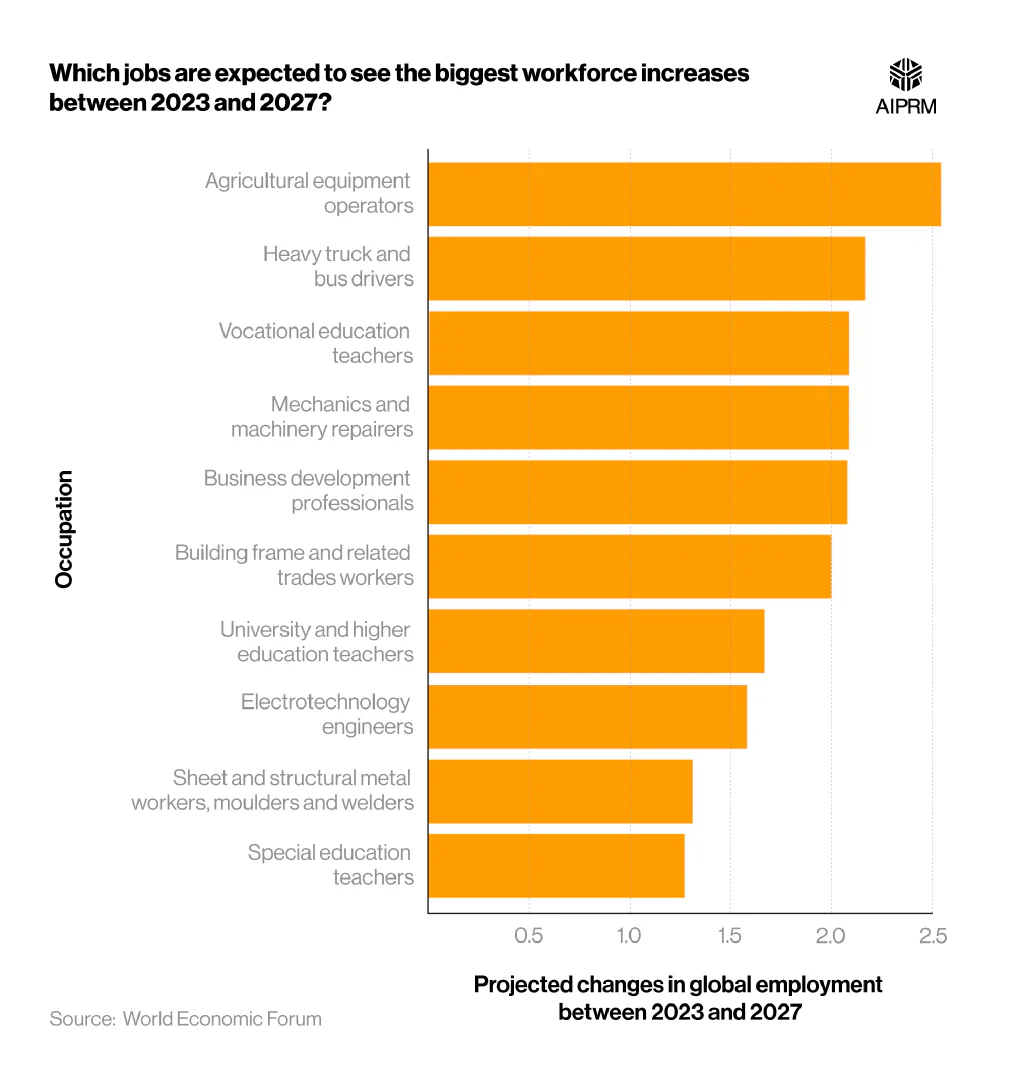
* figures are estimates based on data tables issued by the Word Economic Forum
Heavy truck and bus drivers were the next highest profession, with projected workplace increases of around 2.2 million.
There were four other roles expecting increases of at least two million, they were:
- Vocational education teachers (approx 2.1 million)
- Mechanics and machinery repairs (approx 2.1 million)
- Business development professionals (approx 2.1 million)
- Building frame and related trades workers (approx 2 million)
Elsewhere, AI in education statistics show that special education teachers are projected to see increases of around 1.25 million workers. This is around 40% less than the increases expected in vocational education teachers.
Which jobs are expected to see the biggest workforce decreases between 2023 and 2027? #
The number of data entry clerks is expected to decline by approximately eight million globally in the 5 years from 2023. This is roughly a third (33%) more than any other profession and over double the total expected for security guards (around 3 million).
A breakdown of the jobs with the highest anticipated employment decrease between 2023 and 2027 #

* figures are estimates based on data tables issued by the Word Economic Forum
Administrative and executive secretaries are expected to see the next biggest impact, with a reduction of around six million jobs. This is approximately 26% more than the next highest profession, making this job the only other one with expected losses above five million.
Accountants, bookkeepers, and payroll clerks are expected to see their combined workforce shrink by approximately 4.75 million, around triple the total expected for bank tellers and related clerks (roughly 1.5 million).
AI effect on workforce skills #
A report from the World Economic Forum found that creative thinking was the skill most organizations cited as increasing in importance. Almost three-quarters (73.2%) chose creative thinking, suggesting AI’s ability to automate many functional tasks may be increasing the focus on creativity.
A breakdown of the top 10 workplace skills deemed to be increasing in importance by organizations (2023) #
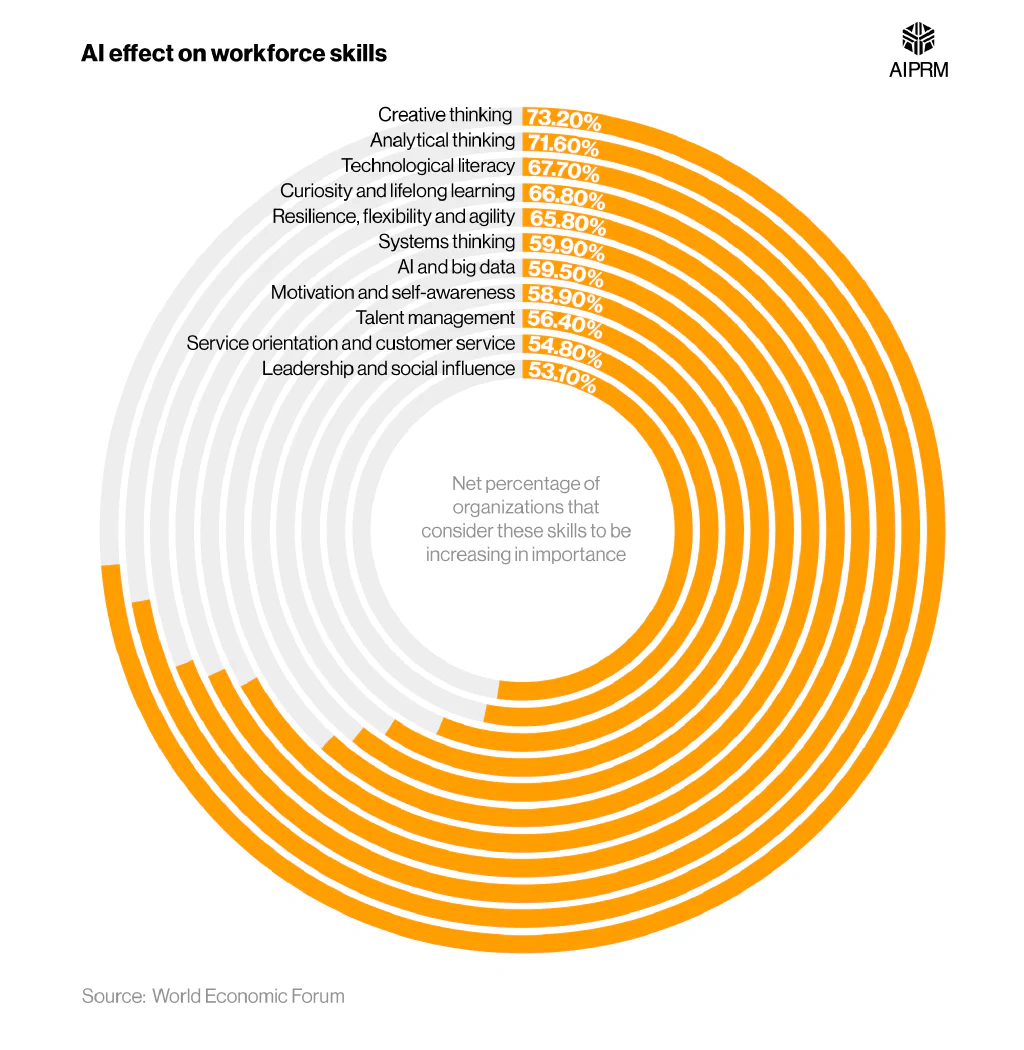
Around 72% of organizations cited analytical thinking as an increasingly important skill, making this the only other attribute chosen by over 70% of companies. Over two-thirds of organizations (67.7%) referenced technological literacy — around 1% more than the number who chose curiosity and lifelong learning (66.8%).
At the other end of the scale, just over half (53.1%) cited leadership and social influence as increasingly important skills — over 20% lower than the number that chose creative thinking.
Visit our blog for expert advice on a range of topics, including crafting effective prompts.
AI effect on productivity #
Despite the mixed attitudes about AI in the workplace, a collection of studies from the Nielsen Norman Group found that support agents who used AI handled 13.8% more customer inquiries per hour than those who didn’t.
The difference was even greater among business professionals, with AI users writing 59% more business documents per hour than non-users.
A breakdown of the productivity increases from AI users for various tasks #
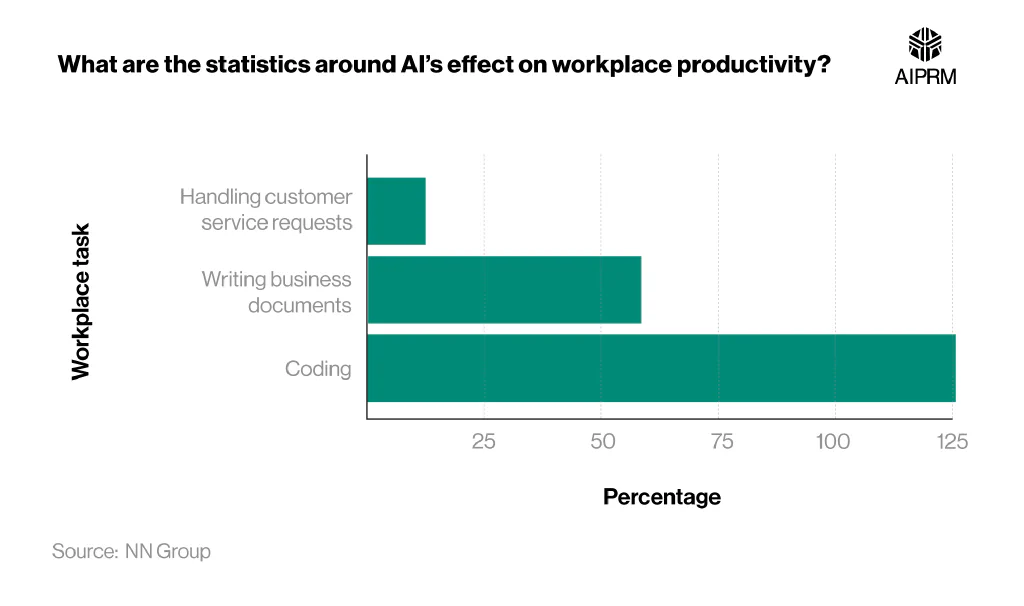
The biggest increase was seen among programmers, with AI users coding more than double (+126%) the projects per week than non-users.
This meant that, on average, AI improved worker productivity by two-thirds (66%) across all three studies.
How do workers feel about data privacy when using AI? #
Nearly a quarter (24%) of workers in the manufacturing and finance industries said they were ‘strongly worried’ about their privacy when using AI. This number rose to almost a third (32%) for workers describing themselves as ‘somewhat worried’, meaning more than half (56%) of workers in these industries have security concerns when using AI.
A breakdown of the levels of worry among workers in the manufacturing and finance industries about privacy while using AI #
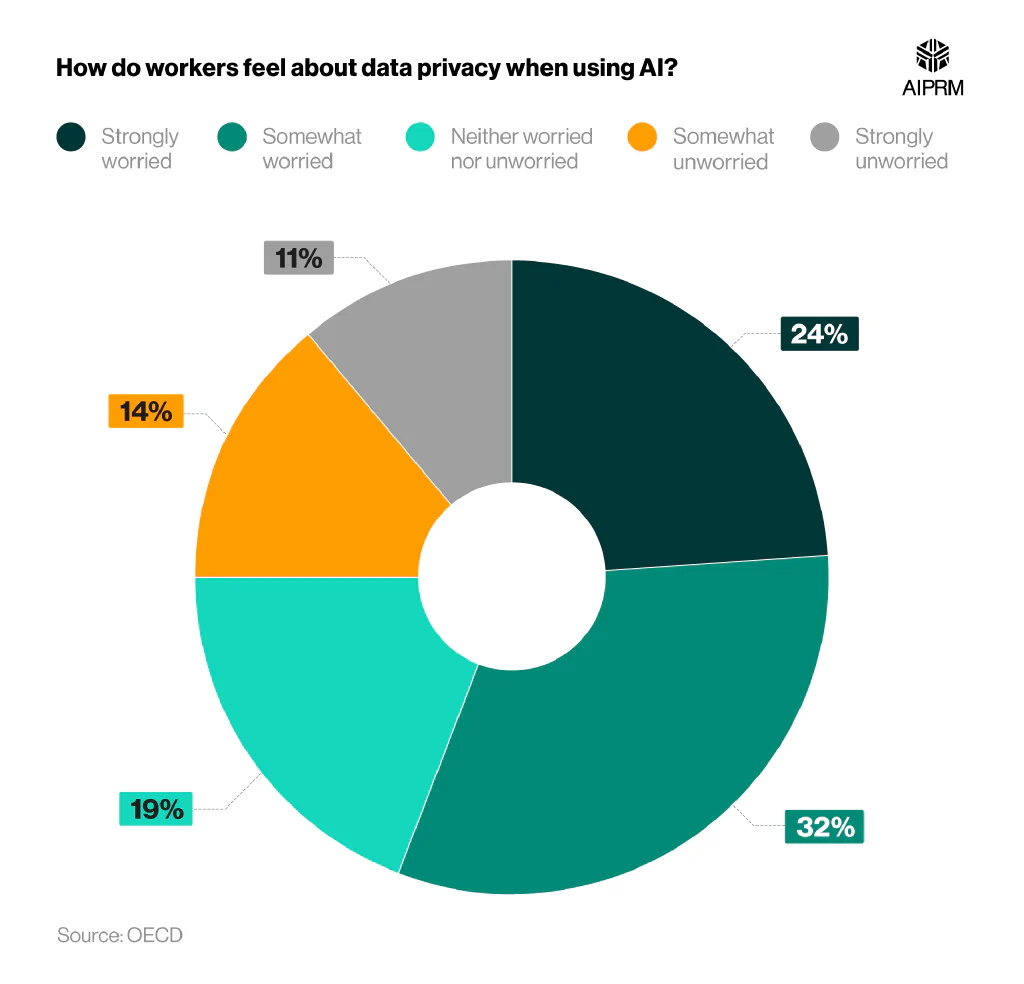
Just over one in ten (11%) described themselves as ‘strongly unworried’ about AI’s effects on privacy, with a further 14% saying they were ‘somewhat unworried’. Overall, this means that a quarter of respondents were unworried about security when using AI.
The future of AI in the workplace #
A 2023 report from McKinsey predicted that AI use may boost the US labor productivity by between 0.5 and 0.9 percentage points annually by 2030 in a midpoint adoption scenario. The range reflects whether the time freed up by automation is redeployed at 2022 productivity levels or the anticipated levels for 2030.
What jobs are most at risk from AI? #
The health sector is expected to see significant rises in labor demand between 2022 and 2030, with 30% rises anticipated for both health professionals and aides, technicians, and workers.
This is 7% more than any other profession, with demand for STEM professionals expected to rise by just under a quarter (23%).
A breakdown of the projected changes in labor demand by industry between 2022 and 2030 #
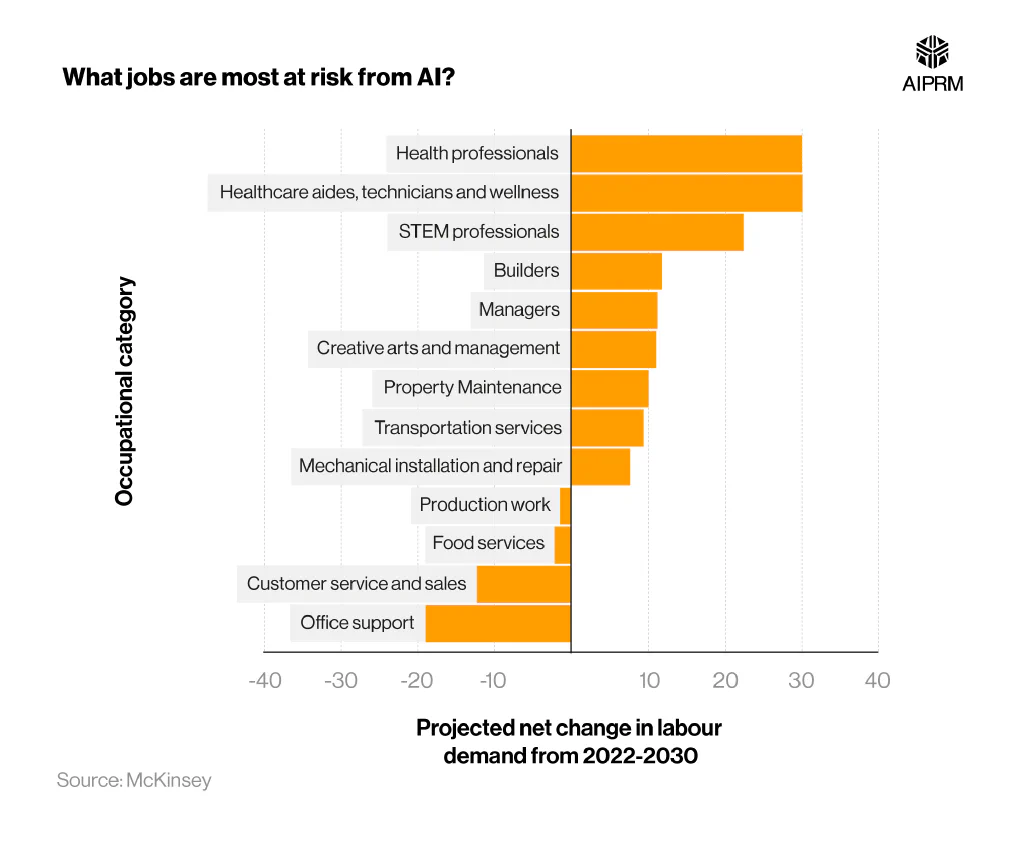
At the other end of the scale, labor demand for office support is expected to drop by nearly (18%) a fifth between 2022 and 2030 — 6% more than any other profession.
Customer service and sales are expected to see a labor demand drop of 13%, making this the only other sector with expected decreases exceeding 10%.
How is AI changing the demand for skills? #
In 2023, just 28% of surveyed employers considered proficiency in STEM to be a critical workforce skill. This represents a 14% decline from 2016 (42%) — the biggest individual drop of any skill.
A breakdown of the changes in the perceived importance of various workplace skills between 2016 and 2023 #
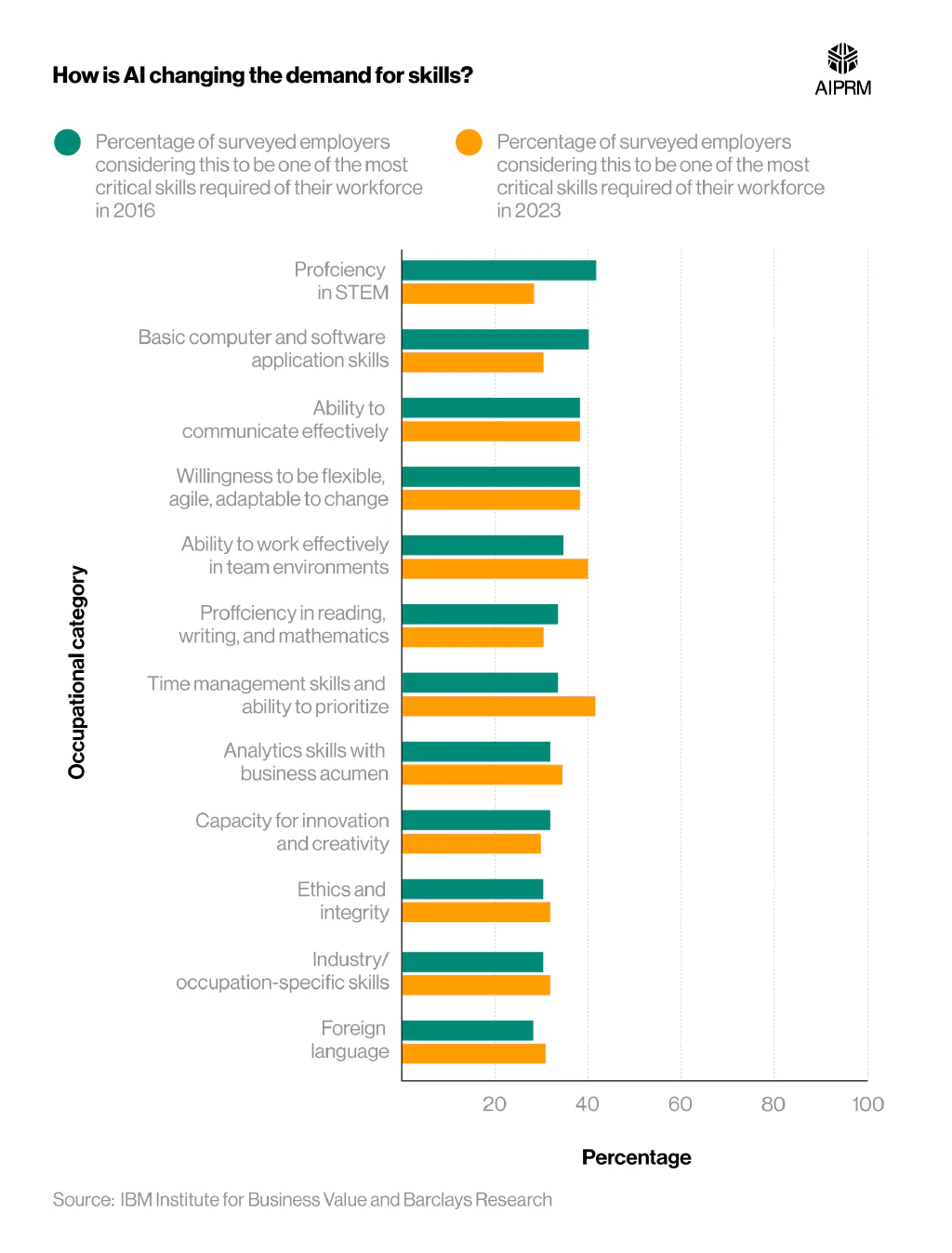
Basic computer and application skills also fell 9% over this period, from 40% to 31%. This suggests that AI’s ability to automate many basic computer tasks may be reducing the perceived value of this skill.
Conversely, 42% cited time management skills as a critical skill in 2023, representing a rise of 9% from 2016. Over the same period, the number of employers selecting working effectively in a team as a key skill rose 5% from 35% to 40%.
What can we learn from history to maximize the potential of AI in the workplace? #
A report from McKinsey looked at the changes in employment levels across various industries between the end of the Industrial Revolution in 1850 and 2015. Agriculture saw its share of the US workforce decline by a huge 55.9 percentage points (pp) over this period, with manufacturing and mining falling by 3.6 pp and 1.3 pp, respectively.
Despite this, there have been significant rises across numerous other industries, most notably trade (12.8 pp), education (9.9 pp), and healthcare (9.3 pp).
A breakdown of the changes in the total employment share by sector in the US between 1850 and 2015 #
| Industry | Changes in employment levels between 1850 and 2015 (percentage points) |
|---|---|
| Trade (retail and wholesale) | 12.8 |
| Construction | 0.3 |
| Transportation | 0.2 |
| Agriculture | -55.9 |
| Manufacturing | -3.6 |
| Mining | -1.3 |
| Household work | 2.71 |
| Professional services | 5 |
| Utilities | 0.8 |
| Business and repair services | 6.1 |
| Telecommunications | 0.7 |
| Healthcare | 9.3 |
| Entertainment | 2.2 |
| Education | 9.9 |
| Government | 4.9 |
| Financial services | 5.9 |
(Source: McKinsey)
Overall, 13 out of the 16 industries covered in the study experienced rises in their workforce share between 1850 and 2015, suggesting that many of the job losses in agriculture were absorbed by growth in other industries.
McKinsey concludes their report by stating their findings prove the following:
Employment shifts can be painful #
While improving technology can create new jobs to offset many of those lost, the transitional process can be painful for workers. This is proven by the decline of the Industrial Revolution, in which average real wages stagnated for decades in England despite improved productivity. Therefore, ensuring workers are properly reskilled in AI will be key to ensuring the technology remains a force for good in our society.
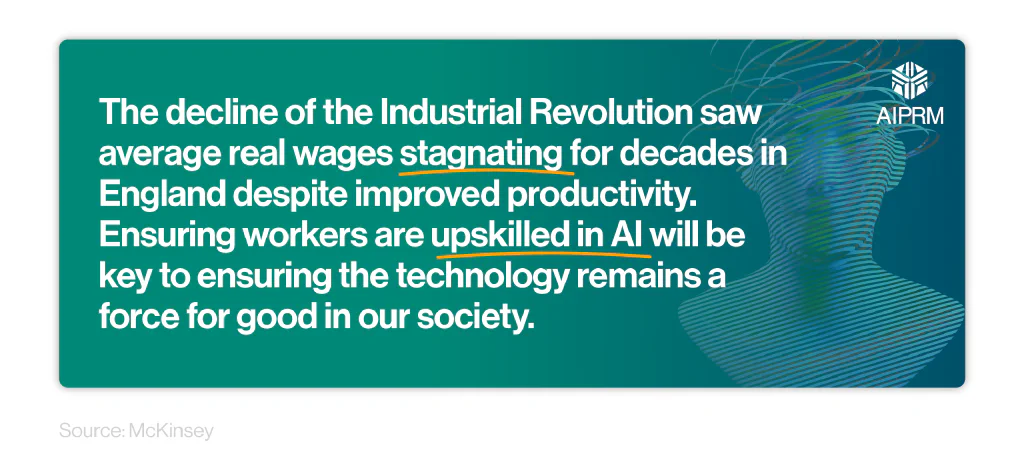
Technology creates more jobs than it destroys, including some you can’t imagine #
New technologies can not only create growth in existing industries but also result in the creation of new jobs and entire industries that wouldn’t have been possible before technological advancements. This claim is backed up by a study from the Federal Reserve Bank of America that found 0.56% of new jobs in the US each year are in new occupations.
We all work less and play more, thanks to technology #
Over time, technology has improved productivity, resulting in a reduction in the length of the average working week. The report validates this claim by revealing that across advanced economies, the length of the average workweek has dropped by nearly 50% since the early 1900s.
With recent AI developments providing the opportunity to automate more tasks than ever before, it’s hoped that efficient use of the technology will result in a kinder working schedule for people across many industries!.
History of AI in the workplace #
While the AI boom may make the technology feel like a new phenomenon, its origins stretch back more than a century. Below, we’ll cover some key moments in the development of AI.
1921 #
Czech playwright Karel Čapek released a science fiction play titled “Rossum’s Universal Robots”. The play is credited for introducing the idea of “artificial people” which he named robots. This was the first known use of the word.
1929 #
Japanese professor Makoto Nishimura built the first Japanese robot, named Gakutensoku.
1950 #
Alan Turing published a paper titled “Computer Machinery and Intelligence”. The paper proposed a test of machine intelligence called The Imitation Game, now commonly referred to as ‘The Turing Test’.
1952 #
American scientist Arthur Samuel developed the first AI program that could play checkers independently.
1958 #
John McCarthy created the first programming language for AI research, known as LISP (an acronym for List Processing).
1966 #
Joseph Weizenbaum created the first chatbot, named ELIZA. The chatbot was a mock psychotherapist that used natural language processing (NLP) to communicate with humans.
1973 #
An applied mathematician named James Lighthill reported to the British Science Council that AI had not made the improvements predicted by scientists. The report resulted in a reduction in funding over the next few decades.
1984 #
The AAAI warns of a pending “AI Winter” that would result in a funding and interest decrease.
1987-93 #
The AI winter arrives, with the LISP-based hardware market collapsing in the wake of popular non-ai-based computer releases from IBM and Apple.
1997 #
IBM software Deep Blue became the first ever AI to defeat a reigning world chess champion, resulting in increased interest and funding in the technology.
In the same year, Microsoft Windows released its first speech recognition software.
2003 #
Nasa landed two rovers on Mars named Spirit and Opportunity. They navigated the surface of the planet without human intervention.
2011 #
Apple released Siri, the first mainstream virtual assistant technology.
2018 #
A Chinese tech group named Alibaba AI defeated a human intellect on a Stanford reading and comprehension test.
2022 #
OpenAI released ChatGPT, a large language model-trained chatbot that redefined the capabilities of AI in responding to human instructions.
2023 #
In response to the success of ChatGPT, Google released its own large language model trained chatbot Google Bard in March 2023. The Chatbot would later be renamed to Gemini.
AI in the workplace FAQs #
Questions about AI in the workplace #
How is AI used in the workplace?
AI is used in a range of ways at work across many industries. Some notable examples include:
- Assisting with creative tasks like writing and image generation
- Automating certain admin-based tasks
- Analyzing data and providing customer insights
- Preventing cybersecurity threats
- Handling customer service queries via chatbots and virtual assistants
While the above examples are notable instances of AI in the workplace, the technology is used in numerous other circumstances today and this is only likely to increase as AI develops further.
How can AI help in the workplace?
AI can substantially increase productivity at work by automating tasks previously carried out by humans at a much quicker rate. The technology can also analyze data to provide insight that companies can use to make key decisions, refining their approach in key business areas.
By assisting with many day-to-day tasks, AI can also enhance employee productivity, giving workers more time to focus on key areas that were previously neglected due to time constraints.
What happens if AI replaces humans in the workplace?
While it’s possible AI may render certain jobs obsolete, the technology offers significant opportunities for growth in many industries. Additionally, developments in AI may even result in the creation of new jobs and sectors that were previously not possible before the AI boom.
History shows us that with the right preparation and reskilling plans, new technology can create more jobs than it destroys.
How can AI be used to increase efficiency in the workplace?
AI increases efficiency in the workplace by automating tasks previously carried out by humans. Often, these tasks are performed at a significantly greater speed resulting in greater productivity, and more time for employees to focus on other key areas of their job.
AI can also analyze data to provide insights to business leaders. The information gained from this data can be used to refine business practices, further increasing productivity and efficiency.
Which jobs are in danger due to AI?
A report from the World Economic Forum predicted that the number of data entry clerks would fall by eight million globally in the five years from 2023. Other jobs predicted to face a significant workforce decline were administrative and executive secretaries (-6 million), and accountants, bookkeepers, and payroll clerks (-4.75 million).
If these figures prove to be correct, it would suggest that the increasing effect of AI automation in these roles has resulted in job losses.
AI in the Workplace Glossary #
Automation #
Automation is the use of technology or machines to perform tasks without significant human intervention.
Generative AI #
Generative AI is a form of AI capable of generating text, images, videos, and code by following human prompts.
Large Language Model (LLM) #
LLMs are a type of machine learning that analyze massive text-based datasets. They recognize patterns and structures in text, producing their own similar outputs that can be used to respond to human queries.
Machine learning #
Machine learning is an AI process that uses computer science, mathematics, and coding to develop algorithms and models. The algorithms and models are then trained to analyze patterns and predict future trends without human assistance.
Sources #
https://www.microsoft.com/en-us/worklab/work-trend-index/ai-at-work-is-here-now-comes-the-hard-part
https://workplaceinsight.net/quarter-of-people-have-now-used-or-tried-ai-in-the-workplace/
https://www3.weforum.org/docs/WEF_Future_of_Jobs_2023.pdf
https://www.statista.com/statistics/1361251/generative-ai-adoption-rate-at-work-by-industry-us/
https://tech.co/news/business-attitudes-ai-workplace
https://www.businessinsider.com/ai-transforming-the-workplace-examples-2023-7
https://en-gb.workplace.com/blog/ai-and-the-future-of-work
https://www.apa.org/topics/healthy-workplaces/artificial-intelligence-workplace-worry
https://x.com/OECD/status/1785700751810916851
https://www.ibm.com/thought-leadership/institute-business-value/en-us/report/ai-capabilities
https://www.nngroup.com/articles/ai-tools-productivity-gains/
https://www.forbes.com/sites/joemckendrick/2023/04/25/yes-ai-increases-productivity-study-suggests/
https://360learning.com/blog/ai-ethics/
https://www.servicedeskinstitute.com/five-ethical-issues-of-ai-in-the-modern-workplace/
https://cpduk.co.uk/news/exploring-ai-ethical-considerations-in-the-workplace
https://www.rospa.com/news-and-views/how-ai-could-transform-workplace-safety
https://www.hse.gov.uk/news/hse-ai.htm
https://academic.oup.com/joh/article/66/1/uiad017/7505756
https://www.mckinsey.com/mgi/our-research/generative-ai-and-the-future-of-work-in-america
https://www.linkedin.com/pulse/brief-history-ai-business-logycco-ktfjc/
https://www.tableau.com/data-insights/ai/history
https://verloop.io/blog/the-timeline-of-artificial-intelligence-from-the-1940